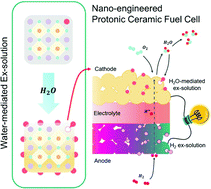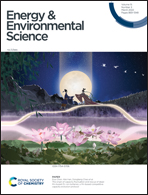Water as a hole-predatory instrument to create metal nanoparticles on triple-conducting oxides†
Abstract
Single-phase materials with mixed ionic and electronic conductivity underpin multiple solid-state electrochemical devices as promising electrodes. In particular, triple-conducting oxides that carry protons, oxygen ions, and electron holes simultaneously have ushered in a breakthrough in improving the performance of ceramic fuel cells, but insufficient electrochemical activity on their surface remains a challenge with regard to the development of related technologies. Here, we present a novel methodology that spontaneously yields transition metal nanocatalysts well dispersed on triple-conducting oxide surfaces realized by simply supplying water vapor with a room-temperature bubbler. The central idea underlying this strategy is the hydrogenation reaction that occurs in protonic ceramics containing redox-active transition metals and the subsequent selective surface phase decomposition. As a case study, Ag-substituted BaCo0.4Fe0.4Zr0.1Y0.1O3−δ is chosen to exemplify the markedly enhanced electrode performance in a fuel cell. The water vapor generated during the operation induces the precipitation of Ag nanoparticles and significantly lowers the electrode resistance to a record level (e.g., 1.20 W cm−2 at 650 °C). These observations suggest a new design direction for oxide-supported catalysts with multiple charge carriers.

- This article is part of the themed collection: Energy & Environmental Science Recent HOT Articles


 Please wait while we load your content...
Please wait while we load your content...